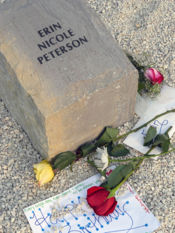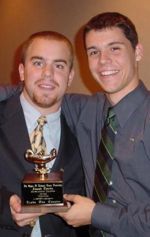Alpha Rho Chapter History Appreciation List
From PhiSigmaPiWiki
The Alpha Rho Chapter History Appreciation List is a list of items and places in Blacksburg that all Alpha Rho initiates are required to find and learn about during their initiation period. The list is comprised of things that are important in the history of Virginia Tech and/or Alpha Rho Chapter. First developed in 2004, the list has been refined over time as new items have been added. The current list is described below.
- Michael B. Perry Memorial Brick – Located on the sidewalk between Top of the Stairs and the Squires Student Center parking lot off of College Avenue. There’s a collection of memorial bricks in the middle of the sidewalk, and the Michael B. Perry Memorial Brick is located on the left side near the bottom. This brick commemorates Mike Perry, a member of the Lambda initiate class, who was killed by a drunk driver in an accident during the summer of 1998. Mike was an avid runner, and thus the annual 5K was renamed for him and is now held in his honor.
- Emily C. Specchio Memorial Bench – Located at the corner of the Duck Pond closest to West Campus Drive, adjacent to the wooden foot bridge. This bench is a memorial to Emily Specchio, a member of the Alpha Alpha initiate class, who passed away from a brain aneurysm in May 2006, two months after being honored with the Alpha Rho Tripod Scholarship and just two days after graduating from Virginia Tech.
- Memorial Stones for Erin Peterson and Reema Samaha – Located on the Drillfield directly in front of Burruss Hall, as part of the 4/16 Memorial. The 4/16 Memorial is a semi-circle of 32 engraved Hokie Stones in memory of the students and faculty who lost their lives in the tragic mass shooting on April 16, 2007 in West Ambler Johnston and Norris Hall. Erin Peterson, a member of the Alpha Eta initiate class, and Reema Samaha, sister of Omar Samaha (member of the Alpha Alpha initiate class), were killed in the tragedy, and they both have commemorative stones in the semi-circle. At the time of her death, Erin had completed all initiation requirements and passed final vote. She was inducted posthumously with the rest of her class. The events of April 16th led to the creation of the Alpha Rho Chapter Endowment Fund, which funds an internal scholarship and grant program in memory of Erin and the other victims.
- Duck Pond Sign – From the Duck Pond gazebo, walk left down the path. The sign will be on the right. The fraternity letters are at the bottom right corner of the sign. This sign was designed and donated by Alpha Rho in the spring of 2002.
- Torchia Award – The Joseph Torchia Outstanding Chapter Award is awarded by Nationals at the annual National Convention to the most outstanding chapter(s) in the country. Alpha Rho has been honored nine times with this award, the highest that can be bestowed upon a chapter. The current president typically possesses the awards, and will typically bring one when he/she speaks at an Initiate meeting.
- Outstanding Student Organization of the Year Award – Phi Sigma Pi received the highest honor Virginia Tech bestows upon student organizations when it was named the Virginia Tech Student Organization of the Year in 1998. The plaque is located on the wall at the top of the stairs on the third floor of Squires Student Center.
- Cenotaph – The large block located in the middle of the Pylons above War Memorial Chapel. A cenotaph, by definition, is a monument constructed in honor of those who are buried elsewhere. Our cenotaph is a memorial to the seven Virginia Tech alumni who have won the Congressional Medal of Honor, and all of their names are inscribed on it.
- Brotherhood Pylon – Located above War Memorial Chapel. The Brotherhood Pylon is the first pylon on the left if you’re facing the Drillfield. Each of the 8 pylons represents different values that one should follow. On each is inscribed a "character trait" of the university, which constituted the true core values of the institution then, as they remain today. Brotherhood, Duty, Honor, Loyalty, Leadership, Service, Sacrifice and Ut Prosim. Also inscribed are the names of 419 alumni and students who died in service to their nation during World Wars I & II, the Korean War, the Vietnam War, Desert Storm, and the current war in Iraq.
- World War I Rock – Located at the base of the flag near Brodie Hall. In remembrance of those alumni who gave their lives in service to their country, “Lest We Forget” is written on the “The Rock”. It is a memorial that honors Virginia Tech alumni who lost their lives in World War I.
- Memorial to the Draper Massacre – From the Wright House, walk past the white, L-shaped house, cross the dam with the stepping stones, and walk toward Duck Pond Drive. The Memorial to the Draper Massacre is the concrete bridge near the street. “The Drapers Meadow Massacre,” it reads, "July 8, 1755." Two hundred fifty years ago, the frontier outpost known as Drapers Meadow ran with blood. As near as anyone can tell, the heart of the settlement was just about between the Virginia Tech Drillfield and the Grove, home of the college president. There was no duck pond then - it wasn't built until the 1900s. Instead there was a low-lying meadowland watered by creeks and springs and dotted with cabins. The attack was a surprise. A band of Shawnee Indians entered the undefended bottomlands, killed at least four people and captured several more. One of the captives, Mary Draper Ingles, later escaped. Her long journey home from a Shawnee village in Kentucky has become a legend. "Follow the River," James Alexander Thom's historical novel based on Ingles' story, has sold more than a million copies. History was not quite so kind to Drapers Meadow. No one can say exactly where it was. The survivors fled. The land was uninhabited for a decade or more after the raid. The log cabins, probably burned by the Indians, have disappeared without a trace. The known dead, as tallied in "Trans-Allegheny Pioneers," were Patton, Mrs. George Draper, Casper Barrier and the Draper baby. Bettie Draper and James Cull were wounded. Bettie Draper, Henry Lenard, Mary Draper Ingles and Ingles' two sons were taken captive. One of them, Thomas Ingles, lived among the Indians for many years and afterward never completely gave up Indian ways. In the aftermath, Drapers Meadow was abandoned - as was much of the frontier for the duration of the French and Indian War. William Preston, who had been in Drapers Meadow on the morning of the attack but left on an errand and so was saved, eventually obtained the property, which became Smithfield Plantation. The other survivors picked up their lives and moved on. The Drapers settled in Pulaski County, in what would become Drapers Valley, said Kegley. William and Mary Ingles started Ingles Ferry, which would operate on the New River for almost 200 years, and Drapers Meadow became a name in stone.

